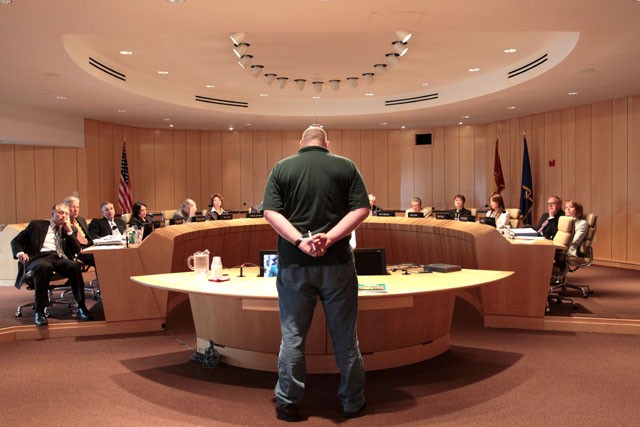The University of Minnesota is one step closer to a year of higher tuition, wage freezes and unfilled faculty positions.
In a Friday meeting, the Board of Regents all but finalized the 2012 operating budget, which saves more than $80 million through wage freezes and cuts to employee benefits and generates nearly $45 million from tuition increases.
With no state funding bill approved at the Capitol, the proposed plan is based on the worst-case scenario for the University âÄî a projected $520 million in funding from the state.
The budget, which took âÄúthousands of hours of work with every unit within the University,âÄù as President Bob Bruininks told the Board, balances the $70.9 million loss in state funding and covers almost $60 million in increased operating costs.
While no major program cuts are planned for any single unit, the University is cutting money across the board, said Richard Pfutzenreuter, the UniversityâÄôs chief finance officer.
âÄúPrograms are being affected everywhere,âÄù he said.
Tuition going up
In the past few years, tuition outgrew state funding as a revenue source for the University for the first time âÄî âÄúa new realityâÄù thatâÄôs unlikely to ever revert, Bruininks told the board.
Under the proposed budget, tuition will increase 5 percent for the majority of in-state undergraduates.
Now that the stimulus grants the U.S. government issued in 2009 have dried up, returning in-state undergraduates would pay 12.5 percent more than in previous years.
Out-of-state students will be hit with an 8.2 percent increase.
The proposed hike âÄî the third major tuition increase in the past decade âÄî has raised concerns about the UniversityâÄôs ability to recruit.
The tuition increases arenâÄôt expected to hurt undergraduate recruitment, Pfutzenreuter said, even among other Big Ten schools.
But Abou Amara, president of the Graduate and Professional Student Assembly, told the board during a public forum Friday that the hike could cost the University talented new graduate students.
âÄúWe canâÄôt bring the best and the brightest here if we continue to raise tuition,âÄù he said.
While the majority of graduate programs will only see a 5 percent increase, tuition at the Law School and the School of Dentistry is going up by 7.4 and 9.3 percent, respectively.
Wage freeze and other cuts
About $21 million of savings is expected to come from a University-wide wage freeze.
However, the budget must account for union bargaining rights.
Every two years, the University negotiates contracts with its four unions. The negotiations usually include improvements to employee benefits and a wage increase.
The current contract ends June 30 âÄî the last day of the UniversityâÄôs fiscal year. Upcoming negotiations have not yet been scheduled.
Pfutzenreuter said when negotiations take place, the UniversityâÄôs position will be that wages are frozen for all employees.
But Phyllis Walker, president of AFSCME 3800, the UniversityâÄôs clerical workersâÄô union, said less funding from the state doesnâÄôt mean the University has no money to increase wages, especially for some of its lowest-paid workers.
Meanwhile, wages are not the only employee benefit under scrutiny.
At FridayâÄôs meeting Regent Richard Beeson told the board the UniversityâÄôs wages are low and benefits are high, compared to other Big Ten schools. But with health care and retirement plans also in line for cuts, he said that the University needs to be mindful of compensation.
âÄúOur competition is gunning for our top people,âÄù he said.
Provost Tom Sullivan told the board that with the loss of funding, the College of Liberal Arts alone would lose 60 planned faculty positions.
As enrollment levels at the University have been steadily increasing in past years, he said without new faculty there would be fewer course offerings and larger class sizes.
Some positions, however, are being phased out purposely with incentivized retirement.
Dann Chapman, director of employee benefits in the Office of Human Resources, said, by last count, more than 375 employees chose to retire since the beginning of the year.
The emptied spots are to be cut, or filled at a lower wage, saving the University millions of dollars, Pfutzenreuter said.
This option helps to prevent layoffs, he said, though a few are still possible.
RegentsâÄô review
The boardâÄôs budget discussion at the Friday meeting ran long.
While unhappy with the prospects, most regents agreed the proposed plan is the only choice.
âÄúActing on this budget will be one of the hardest things weâÄôll do,âÄù Regent Patricia Simmons said, but itâÄôs âÄúthe best we can do under the circumstances.âÄù
But Regent Steve Sviggum showed more skepticism and sparred with his fellow regents at the meeting.
During general discussion he said more reductions can be made to nonacademic and nonresearch positions.
He also questioned the UniversityâÄôs financial aid spending and said he is concerned about raising everyoneâÄôs tuition only to give financial aid to a select few.
The other regents disagreed.
The board will vote on the budget proposal at a special meeting June 20.
Regent Chairman Clyde Allen said that the final budget is still subject to change, depending on what happens at the Capitol, though itâÄôs unlikely.


